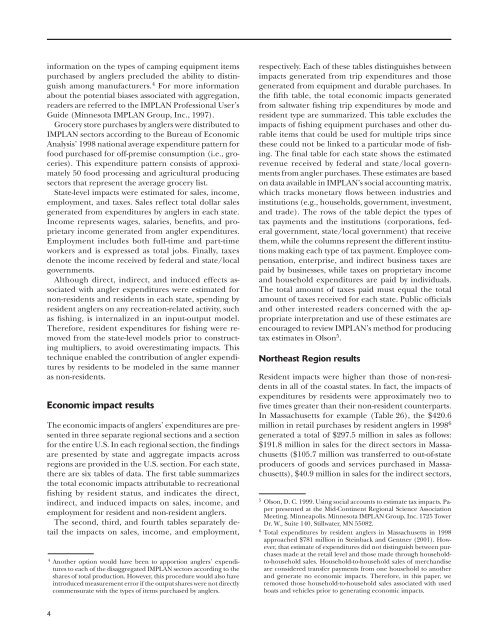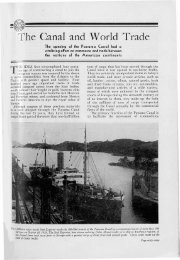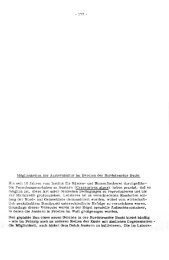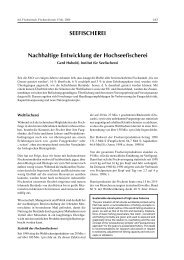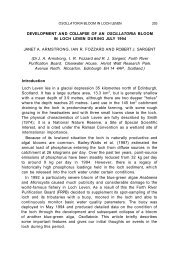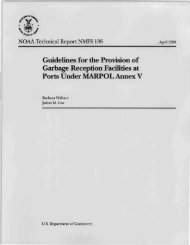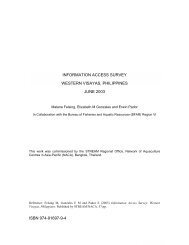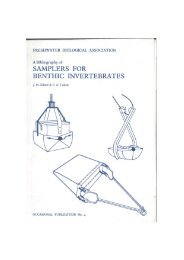The Economic Importance Of Marine Angler Expenditures In
The Economic Importance Of Marine Angler Expenditures In
The Economic Importance Of Marine Angler Expenditures In
Create successful ePaper yourself
Turn your PDF publications into a flip-book with our unique Google optimized e-Paper software.
information on the types of camping equipment items<br />
purchased by anglers precluded the ability to distinguish<br />
among manufacturers. 4 For more information<br />
about the potential biases associated with aggregation,<br />
readers are referred to the IMPLAN Professional User’s<br />
Guide (Minnesota IMPLAN Group, <strong>In</strong>c., 1997).<br />
Grocery store purchases by anglers were distributed to<br />
IMPLAN sectors according to the Bureau of <strong>Economic</strong><br />
Analysis’ 1998 national average expenditure pattern for<br />
food purchased for off-premise consumption (i.e., groceries).<br />
This expenditure pattern consists of approximately<br />
50 food processing and agricultural producing<br />
sectors that represent the average grocery list.<br />
State-level impacts were estimated for sales, income,<br />
employment, and taxes. Sales reflect total dollar sales<br />
generated from expenditures by anglers in each state.<br />
<strong>In</strong>come represents wages, salaries, benefits, and proprietary<br />
income generated from angler expenditures.<br />
Employment includes both full-time and part-time<br />
workers and is expressed as total jobs. Finally, taxes<br />
denote the income received by federal and state/local<br />
governments.<br />
Although direct, indirect, and induced effects associated<br />
with angler expenditures were estimated for<br />
non-residents and residents in each state, spending by<br />
resident anglers on any recreation-related activity, such<br />
as fishing, is internalized in an input-output model.<br />
<strong>The</strong>refore, resident expenditures for fishing were removed<br />
from the state-level models prior to constructing<br />
multipliers, to avoid overestimating impacts. This<br />
technique enabled the contribution of angler expenditures<br />
by residents to be modeled in the same manner<br />
as non-residents.<br />
<strong>Economic</strong> impact results<br />
<strong>The</strong> economic impacts of anglers’ expenditures are presented<br />
in three separate regional sections and a section<br />
for the entire U.S. <strong>In</strong> each regional section, the findings<br />
are presented by state and aggregate impacts across<br />
regions are provided in the U.S. section. For each state,<br />
there are six tables of data. <strong>The</strong> first table summarizes<br />
the total economic impacts attributable to recreational<br />
fishing by resident status, and indicates the direct,<br />
indirect, and induced impacts on sales, income, and<br />
employment for resident and non-resident anglers.<br />
<strong>The</strong> second, third, and fourth tables separately detail<br />
the impacts on sales, income, and employment,<br />
4 Another option would have been to apportion anglers’ expenditures<br />
to each of the disaggregated IMPLAN sectors according to the<br />
shares of total production. However, this procedure would also have<br />
introduced measurement error if the output shares were not directly<br />
commensurate with the types of items purchased by anglers.<br />
4<br />
respectively. Each of these tables distinguishes between<br />
impacts generated from trip expenditures and those<br />
generated from equipment and durable purchases. <strong>In</strong><br />
the fifth table, the total economic impacts generated<br />
from saltwater fishing trip expenditures by mode and<br />
resident type are summarized. This table excludes the<br />
impacts of fishing equipment purchases and other durable<br />
items that could be used for multiple trips since<br />
these could not be linked to a particular mode of fishing.<br />
<strong>The</strong> final table for each state shows the estimated<br />
revenue received by federal and state/local governments<br />
from angler purchases. <strong>The</strong>se estimates are based<br />
on data available in IMPLAN’s social accounting matrix,<br />
which tracks monetary flows between industries and<br />
institutions (e.g., households, government, investment,<br />
and trade). <strong>The</strong> rows of the table depict the types of<br />
tax payments and the institutions (corporations, federal<br />
government, state/local government) that receive<br />
them, while the columns represent the different institutions<br />
making each type of tax payment. Employee compensation,<br />
enterprise, and indirect business taxes are<br />
paid by businesses, while taxes on proprietary income<br />
and household expenditures are paid by individuals.<br />
<strong>The</strong> total amount of taxes paid must equal the total<br />
amount of taxes received for each state. Public officials<br />
and other interested readers concerned with the appropriate<br />
interpretation and use of these estimates are<br />
encouraged to review IMPLAN’s method for producing<br />
tax estimates in Olson 5 .<br />
Northeast Region results<br />
Resident impacts were higher than those of non-residents<br />
in all of the coastal states. <strong>In</strong> fact, the impacts of<br />
expenditures by residents were approximately two to<br />
five times greater than their non-resident counterparts.<br />
<strong>In</strong> Massachusetts for example (Table 26), the $420.6<br />
million in retail purchases by resident anglers in 1998 6<br />
generated a total of $297.5 million in sales as follows:<br />
$191.8 million in sales for the direct sectors in Massachusetts<br />
($105.7 million was transferred to out-of-state<br />
producers of goods and services purchased in Massachusetts),<br />
$40.9 million in sales for the indirect sectors,<br />
5 Olson, D. C. 1999. Using social accounts to estimate tax impacts. Paper<br />
presented at the Mid-Continent Regional Science Association<br />
Meeting. Minneapolis. Minnesota IMPLAN Group, <strong>In</strong>c. 1725 Tower<br />
Dr. W., Suite 140, Stillwater, MN 55082.<br />
6 Total expenditures by resident anglers in Massachusetts in 1998<br />
approached $781 million in Steinback and Gentner (2001). However,<br />
that estimate of expenditures did not distinguish between purchases<br />
made at the retail level and those made through householdto-household<br />
sales. Household-to-household sales of merchandise<br />
are considered transfer payments from one household to another<br />
and generate no economic impacts. <strong>The</strong>refore, in this paper, we<br />
removed those household-to-household sales associated with used<br />
boats and vehicles prior to generating economic impacts.


